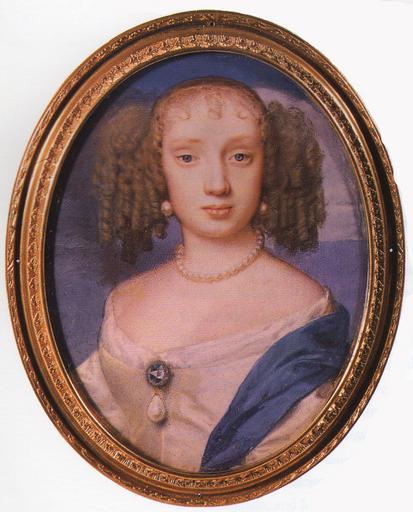MAKE A MEME
View Large Image

| View Original: | Minette-Stuart.jpg (650x805) | |||
| Download: | Original | Medium | Small | Thumb |
| Courtesy of: | commons.wikimedia.org | More Like This | ||
| Keywords: people round Today, Henrietta is best known through her correspondence with her brother King Charles II of England, with whom she was very close. With her brother, she helped to negotiate the Secret Treaty of Dover (1670), which was an offensive and defensive alliance between England and France. When she visited her brother at Dover, she was accompanied by one of her ladies-in-waiting, Louise de Kérouaille. The English king became fascinated with Louise. After Henrietta's death, Louise was appointed by Charles to become a lady-in-waiting to his wife, the Portuguese princess Catherine of Braganza, and became his mistress. Henrietta died at the Château de Saint-Cloud, near Paris on 30 June 1670, just two weeks after the treaty was signed. At the time of her death, it was widely believed that Henrietta-Anne had been poisoned by friends of her husband’s jealous lover and exiled favourite, the Chevalier de Lorraine. An autopsy was performed, however, and it was reported that Henrietta-Anne had died of peritonitis caused by a perforated ulcer.[8] At her funeral, the well-known orator Jacques-Bénigne Bossuet conducted her eulogy, the famous Oraison funèbre d'Henriette d'Angleterre. Her widowed husband took Elizabeth Charlotte of the Palatinate as his second wife; she was the daughter of Henrietta's first cousin. * Her eldest daughter died without issue. * Through her youngest daughter, Anne Marie d'Orléans, she is a direct ancestor of Louis XV and his descendants, the last Bourbon kings of France before the reign of Louis Philippe, King of the French, a descendant of her husband and his second wife. Today, Henrietta is best known through her correspondence with her brother King Charles II of England, with whom she was very close. With her brother, she helped to negotiate the Secret Treaty of Dover (1670), which was an offensive and defensive alliance between England and France. When she visited her brother at Dover, she was accompanied by one of her ladies-in-waiting, Louise de Kérouaille. The English king became fascinated with Louise. After Henrietta's death, Louise was appointed by Charles to become a lady-in-waiting to his wife, the Portuguese princess Catherine of Braganza, and became his mistress. Henrietta died at the Château de Saint-Cloud, near Paris on 30 June 1670, just two weeks after the treaty was signed. At the time of her death, it was widely believed that Henrietta-Anne had been poisoned by friends of her husband’s jealous lover and exiled favourite, the Chevalier de Lorraine. An autopsy was performed, however, and it was reported that Henrietta-Anne had died of peritonitis caused by a perforated ulcer.[8] At her funeral, the well-known orator Jacques-Bénigne Bossuet conducted her eulogy, the famous Oraison funèbre d'Henriette d'Angleterre. Her widowed husband took Elizabeth Charlotte of the Palatinate as his second wife; she was the daughter of Henrietta's first cousin. * Her eldest daughter died without issue. * Through her youngest daughter, Anne Marie d'Orléans, she is a direct ancestor of Louis XV and his descendants, the last Bourbon kings of France before the reign of Louis Philippe, King of the French, a descendant of her husband and his second wife. Minette-Stuart.jpg century 17 painting Institution unknown unknown other versions PD-old-100 17th-century unidentified court painters 17th-century portrait paintings location missing Henrietta of England 17th-century portrait paintings not categorised by year F 17th-century oval portrait paintings of women at bust length Female hair fashion in art Females with earrings in art Females with pearl jewellery in art Females with pearl necklaces in art Painting frames Today, Henrietta is best known through her correspondence with her brother King Charles II of England, with whom she was very close. With her brother, she helped to negotiate the Secret Treaty of Dover (1670), which was an offensive and defensive alliance between England and France. When she visited her brother at Dover, she was accompanied by one of her ladies-in-waiting, Louise de Kérouaille. The English king became fascinated with Louise. After Henrietta's death, Louise was appointed by Charles to become a lady-in-waiting to his wife, the Portuguese princess Catherine of Braganza, and became his mistress. Henrietta died at the Château de Saint-Cloud, near Paris on 30 June 1670, just two weeks after the treaty was signed. At the time of her death, it was widely believed that Henrietta-Anne had been poisoned by friends of her husband’s jealous lover and exiled favourite, the Chevalier de Lorraine. An autopsy was performed, however, and it was reported that Henrietta-Anne had died of peritonitis caused by a perforated ulcer.[8] At her funeral, the well-known orator Jacques-Bénigne Bossuet conducted her eulogy, the famous Oraison funèbre d'Henriette d'Angleterre. Her widowed husband took Elizabeth Charlotte of the Palatinate as his second wife; she was the daughter of Henrietta's first cousin. * Her eldest daughter died without issue. * Through her youngest daughter, Anne Marie d'Orléans, she is a direct ancestor of Louis XV and his descendants, the last Bourbon kings of France before the reign of Louis Philippe, King of the French, a descendant of her husband and his second wife. | ||||